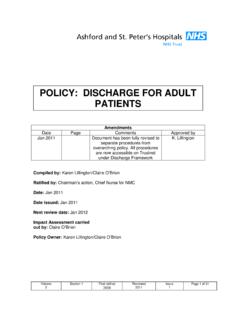Transcription of Using patient feedback - NHS Surveys
1 Using patient feedbackQuality improvement: the help you needMeasuring patients experiences of care and treatment highlights areas that need to improve to provide a patient -led healthcare Picker Institute s quality improvement activities help you to involve patients , staff and the public in translating patient feedback into real startedVisit for practical resources and more information to help you carry out effective quality improvement. What patients wantThrough extensive work with patients the Picker Institute has identified those issues found to be most important to them: fast access to reliable health advice effective treatment delivered by trusted professionals participation in decisions and respect for preferences clear, comprehensible information and support for self-care attention to physical and environmental needs emotional support, empathy and respect involvement of, and support for family and carers continuity of care and smooth Institute Europe King s Mead House Oxpens Road Oxford OX1 1 RXTel: 01865 208100 Fax: 01865 208101 Email: Website.
2 Charity no 1081688 Company limited by registered guarantee no 3908160 patient feedback : helping you to improve patient experienceSection 5: Action planning for improvement1 How can you meet tHe cHallenge of improving services in your healthcare organisation? wHo tHis guide is for tHe purpose of tHis guideThe first step is to find out what patients and service users think by asking about their experiences. Examining feedback will give a direct insight into what is working well and not so well in the way your organisation delivers care. You will discover examples of good practice where lessons can be learnt, and, areas of concern where improvements can be made. This guide is written for healthcare staff who care about patient experience and engagement and want to improve care for patients .
3 This guide will explain the basic principles of gathering patient feedback and provides an overview of the different methods and techniques. It outlines what to do with feedback once you have collected it in order to bring about improvements to healthcare guidance is based on what patients say is important, and what healthcare staff tell us works find out more or to download the full pack, visit Picker Institute Europe 20091 Lord Darzi, NHS Next Stage ReviewIntroductionUSING patient feedback : a practical guide to improving patient experienceSECTION 1 If quality is to be at the heart of everything we do, it must be understood from the perspective of patients . 12 How to use tHis guidewHere it works: quality improvement in actionicons used in tHis guideacknowledgementsThis guide is comprised of a number of sections, including:>> What patient feedback is and how you obtain it>> Understanding findings from your Surveys >> Sharing feedback >> Action planning for improvement>> Getting key stakeholders involvedEach section is designed to give you an outline of the topic and how it can be used, along with practical tools and resources to support implementation.
4 Case studies are included which show how healthcare organisations have used patient feedback to bring about improvements. A number of icons have been used throughout this guide to help draw your attention to certain pieces of information. This is what they mean:A key principleHow to find out moreSee another section in the guideThe Picker Institute is grateful to the contributions and insights from the many patients and healthcare professionals with whom it has worked on quality improvement projects and on whose experiences it has and tested: by healthcare professionalstop tipsapproacHes to tackling key strategic tasksstep by stepEach case study is coded according to the key principles it illustrates, Using the following code:Understandingresults/dataInvolvingo thersAction planningCommunicatingLinking with other workGathering feedbackUnderstanding results/dataUnderstandingresults/dataInv olvingothersAction planningCommunicatingLinking with other workGathering feedbackGathering feedbackUnderstandingresults/dataInvolvi ngothersAction planningCommunicatingLinking with other workGathering feedbackCommunicatingUnderstandingresult s/dataInvolvingothersAction planningCommunicatingLinking with other workGathering feedbackLinking with other workUnderstandingresults/dataInvolvingot hersAction planningCommunicatingLinking with other workGathering feedbackInvolving othersUnderstandingresults/dataInvolving othersAction planningCommunicatingLinking with other workGathering
5 FeedbackAction planning Using patient feedback : a practical guide to improving patient experienceTo find out more or to download the full pack, visit Picker Institute Europe 2009To find out more or to download the full pack, visit Picker Institute Europe 2009 Using patient feedback : a practical guide to improving patient experienceSection 2: What patient feedback is and how you obtain it1 What is patient feedback ? patient feedback consists of the views and opinions of patients and service users on the care they have experienced. healthcare organisations can gather patient feedback in a variety of ways including Surveys , audits, comments and complaints. Staff who work directly with patients can also offer a useful addition, reliable evidence can be gathered systematically Using a range of techniques including focus groups, one-to-one interviews and mystery shopping.
6 It is important to select the most appropriate method for your task. Quantitative research techniques such as Surveys enable the gathering and analysis of a large number of views about certain issues. They generate numerical data about the number of people who think about a topic in a particular such as focus groups and interviews are examples of qualitative research. They provide an in-depth examination of views and opinions and provide stories and narratives from the people taking gather patient feedback ?The real test of performance by the NHS or any healthcare provider must be the views and experiences of its users. By asking patients in a rigorous, systematic fashion about their experiences of care and treatment healthcare services can be accurately measured and improvements made.
7 What patient feedback is and how you obtain itUnderstandingresults/dataInvolvingothe rsAction planningCommunicatingLinking with other workGathering feedbackUSING patient feedback : a practical guide to improving patient experienceSECTION 2 Gathering the views of patients and service users is more complex than it may initially appear. To obtain reliable, rigorous evidence the exercise must be carried out systematically. To find out more or to download the full pack, visit Picker Institute Europe 2009 Using patient feedback : a practical guide to improving patient experienceSection 2: What patient feedback is and how you obtain it2 Quantitative research patient experience surveysPatient experience Surveys are the best method of gathering feedback when you want to know the views of a large number of people.
8 They allow you to study patterns and trends and to see how common certain experiences are. They show if a problem is occurring more or less frequently over time and the types of people who seem most likely to experience should be developed with patients before they are used to ensure they are appropriate. Surveys can be carried out by post, telephone, online or electronically with hand-held and other devices. National patient surveysAll NHS healthcare organisations in England and Scotland are currently required to carry out postal Surveys asking patients for their views on their recent experiences. By surveying consistently and systematically these large Surveys build up a detailed picture of patients experiences. Regularly repeating the same type of survey enables changes over time to be monitored and performance compared.
9 National Surveys are valuable because they allow you to compare results locally against the performance of similar organisations. The results also enable regulators and policy makers to examine individual organisations and overall performance across the experience Surveys : more than just a measure of satisfaction Examining experience patient experience Surveys ask service users specific factual questions about what happened to them during their recent healthcare experience. For example, reporting style questions such as:Did a member of staff tell you about medication side effects to watch for when you went home?provide useful information because they highlight precisely where the problems are, and what needs to be done to improve particular elements of patient care.
10 Traditional satisfaction or rating style questions, such as: Overall, how would you rate the care you received? are considered less useful because they do not provide a clear indication of what needs to be done to improve care. For instance, knowing that 15% of patients rate the service as fair or poor gives few clues about where to start to make the service better. Having more precise information about what went wrong, such as 23% of patients not being given an understandable explanation of their test results, is much more helpful when setting priorities for improvement. Task Monitoring performance and assessing qualityDetermining priorities of the local population Ongoing engagement Identifying issues of concern to key stakeholdersIn-depth investigation of attitudes and beliefs Testing services Public consultationResearch method Quantitative patient experience Surveys Population surveysQualitative patient panelsAnalysis of written materialsFocus groups One to one interviewsMystery shopping Observation in healthcare settingsDeliberative events choosing the right research methodTo find out more or to download the full pack, visit Picker Institute Europe 2009 Using patient feedback : a practical guide to improving patient experienceSection 2.





